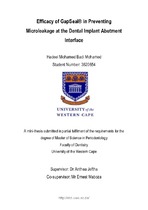| dc.contributor.advisor | Jeftha, Anthea | |
| dc.contributor.advisor | Maboza, Ernest | |
| dc.contributor.author | Badi Mohamed, Hadeel Mohamed | |
| dc.date.accessioned | 2021-03-26T08:10:13Z | |
| dc.date.available | 2021-03-26T08:10:13Z | |
| dc.date.issued | 2021 | |
| dc.identifier.uri | http://hdl.handle.net/11394/8063 | |
| dc.description | Magister Chirurgiae Dentium (MChD) | en_US |
| dc.description.abstract | Dental implants have proven to be a success in the past decades, however the inevitable presence of microgaps at the implant abutment interface leading to microleakage is still a distressing concern. Microbial leakage can lead to peri-implant disease and bone loss and reduces implants' success rates. Measures to decrease the effect of the microgap were introduced; amongst them is the application of silicone sealing gels, such as GapSeal®. | en_US |
| dc.language.iso | en | en_US |
| dc.publisher | University of Western Cape | en_US |
| dc.subject | Gapseal® | en_US |
| dc.subject | Implant abutment interface | en_US |
| dc.subject | Microleakage | en_US |
| dc.subject | Dynamic loading | en_US |
| dc.subject | Chewing simulator | en_US |
| dc.title | Efficacy of gapseal® in preventing microleakage at the dental implant abutment interface | en_US |
| dc.rights.holder | University of Western Cape | en_US |

